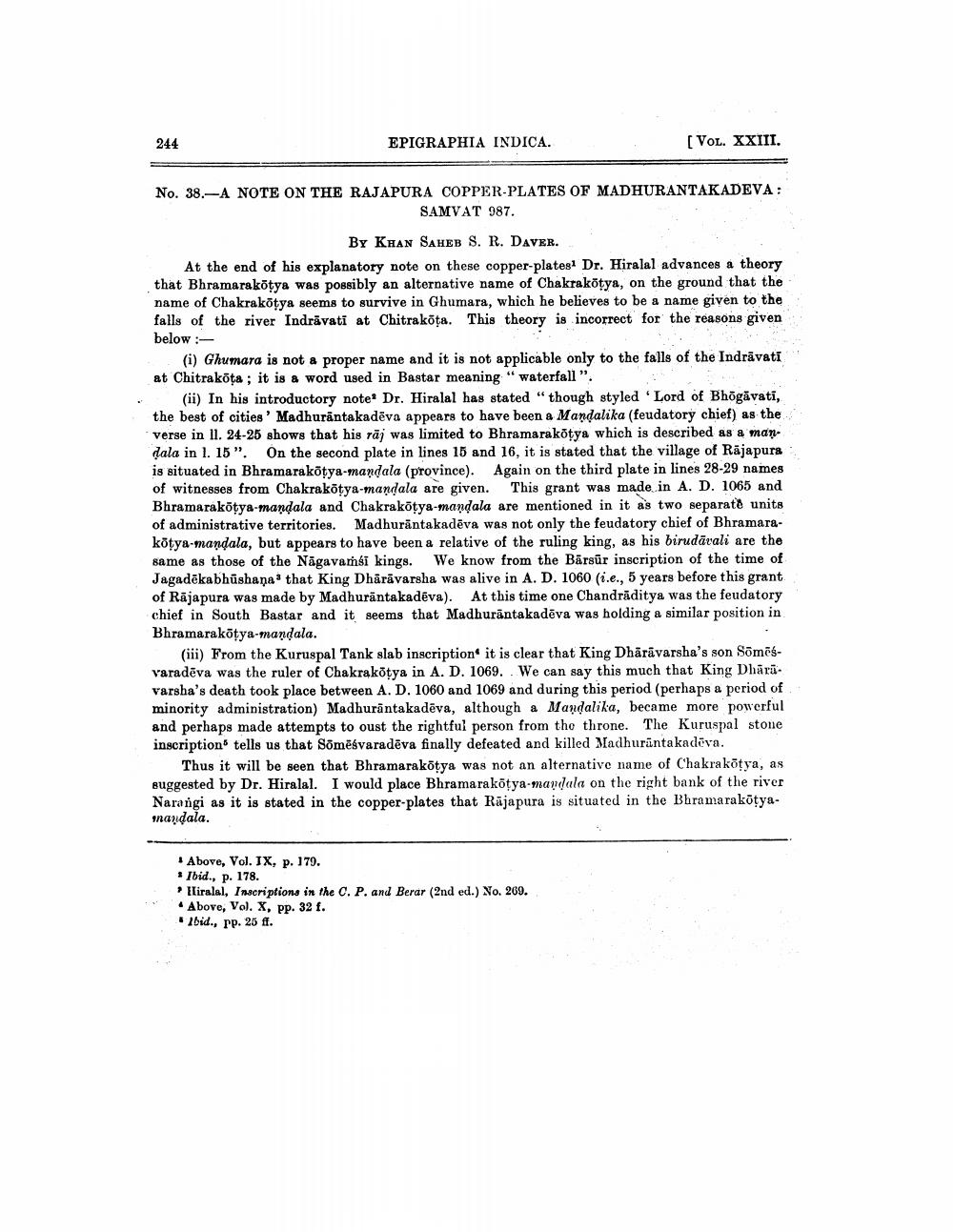________________
244
EPIGRAPHIA INDICA.
[VOL. XXIII.
No. 38.-A NOTE ON THE RAJAPURA COPPER-PLATES OF MADHURANTAKADEVA:
SAMVAT 987.
BY KHAN SAHEB S. R. DAVER.
At the end of his explanatory note on these copper-plates1 Dr. Hiralal advances a theory that Bhramarakōtya was possibly an alternative name of Chakrakōtya, on the ground that the name of Chakrakōtya seems to survive in Ghumara, which he believes to be a name given to the falls of the river Indravati at Chitrakōta. This theory is incorrect for the reasons given below:
(i) Ghumara is not a proper name and it is not applicable only to the falls of the Indravati at Chitrakōta; it is a word used in Bastar meaning "waterfall".
(ii) In his introductory note Dr. Hiralal has stated "though styled 'Lord of Bhōgavati, the best of cities' Madhurantakadēva appears to have been a Mandalika (feudatory chief) as the verse in ll. 24-25 shows that his raj was limited to Bhramarakōtya which is described as a mandala in 1. 15". On the second plate in lines 15 and 16, it is stated that the village of Rajapura is situated in Bhramarakötya-mandala (province). Again on the third plate in lines 28-29 names of witnesses from Chakrakōtya-mandala are given. This grant was made in A. D. 1065 and Bhramarakōtya-mandala and Chakrakōtya-mandala are mentioned in it as two separate units of administrative territories. Madhurantakadēva was not only the feudatory chief of Bhramarakötya-mandala, but appears to have been a relative of the ruling king, as his birudavali are the same as those of the Nagavaṁsi kings. We know from the Bärsür inscription of the time of Jagadēkabhushana that King Dhärävarsha was alive in A. D. 1060 (i.e., 5 years before this grant. of Rajapura was made by Madhuräntakadēva). At this time one Chandraditya was the feudatory chief in South Bastar and it seems that Madhurantakadēva was holding a similar position in Bhramarakōtya-mandala.
(iii) From the Kuruspal Tank slab inscription it is clear that King Dhärävarsha's son Sōmesvaradeva was the ruler of Chakrakoṭya in A. D. 1069. We can say this much that King Dhara varsha's death took place between A. D. 1060 and 1069 and during this period (perhaps a period of minority administration) Madhurantakadeva, although a Mandalika, became more powerful and perhaps made attempts to oust the rightful person from the throne. The Kuruspal stone inscription tells us that Sōmesvaradeva finally defeated and killed Madhurantakadeva.
Thus it will be seen that Bhramarakōṭya was not an alternative name of Chakrakōtya, as suggested by Dr. Hiralal. I would place Bhramarakōtya-mandala on the right bank of the river Narangi as it is stated in the copper-plates that Rajapura is situated in the Bhramarakōṭyamandala.
Above, Vol. IX, p. 179.
* Ibid., p. 178.
Hiralal, Inscriptions in the C. P. and Berar (2nd ed.) No. 269.
Above, Vol. X, pp. 32 f.
Ibid., pp. 25 ff.




